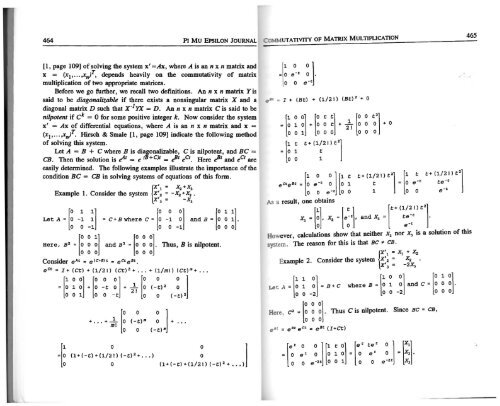Vol. 10 No 6 - Pi Mu Epsilon
Vol. 10 No 6 - Pi Mu Epsilon
Vol. 10 No 6 - Pi Mu Epsilon
- No tags were found...
Create successful ePaper yourself
Turn your PDF publications into a flip-book with our unique Google optimized e-Paper software.
464 PI MU EPSILON JOURNAL<br />
[1, page <strong>10</strong>9] of solving the system x'=Ax, where A is ann x n matrix and<br />
x = (x 1 , ••• ,x,.)T, depends heavily on the commutativity of matrix<br />
multiplication of two appropriate matrices.<br />
Before we go further, we recall two definitions. An n x n matrix Y is<br />
said to be diagonalizable if there exists a nonsingular matrix X and a<br />
diagonal matrix D such that x-lyx. =D. Ann x n matrix Cis said to be<br />
nilpotent if ck = 0 for some positive integer k. <strong>No</strong>w consider the system<br />
x' = Ax of differential equations, where A is an n x n matrix and x =<br />
(x 1 , ... ,x,.JT. Hirsch & Smale [1, page <strong>10</strong>9] indicate the following method<br />
of solving this system.<br />
Let A = B + C where B is diagonalizable, C is nilpotent, and BC =<br />
CB. Then the solution is e-4' = e (B+C)t = ,Jlt ec 1 • Here ,/l' and ec' are<br />
easily determined. The following examples illustrate the importance of the<br />
condition BC = CB in solving systems of equations of this form.<br />
X'l = Xz +Xl<br />
Example 1. Consider the system X' 2 = - X 2 + X 3 •<br />
{<br />
x'l =<br />
Let A"~~ -~ -~l • C+Bwhere C" ~~ -~ -~l and B "~~ ~ ~]·<br />
-xl<br />
Here, B 2 = ~~ ~ ~1 and B 3 = ~~ ~ ~]. Thus, B is nilpotent.<br />
000 000<br />
Consider eAt = e
















